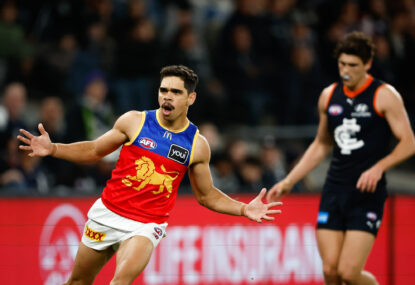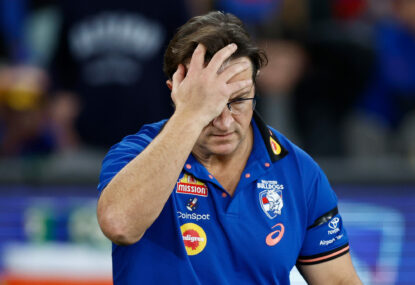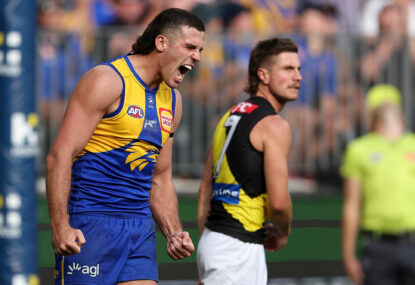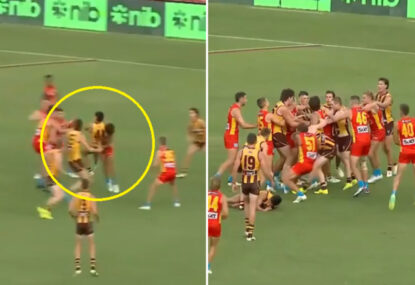I was watching the NBA draft lottery nearly nine months ago and like most people, I was stunned when the ping pong balls made Zion Williamson a New Orleans Pelican.
Maybe the small-market team deserved to land him given how harshly Anthony Davis treated them, but I can’t help wondering what the Zion experience at Madison Square Garden would have been like. That said, the New York Knicks are a basket case so perhaps it’s best he went literally anywhere else.
I wonder similarly about how certain AFL players would have fared if drafted to different clubs? The two standout examples for me are Jack Watts and David Swallow.
Nic Naitanui should have been taken ahead of Watts, but that doesn’t detract from what a special talent Watts was considered to be.
For injury reasons, Naitanui himself has failed to live up to his talent, albeit to a lesser degree. Parsing the factors why draft picks fail (or succeed) is fraught without firsthand knowledge of a player’s development but being drafted to a poorly-run club can hardly help.
Watts and Swallow were thrust into the worst club environments in recent AFL history, both in terms of on-field performance and off-field administration.
The era at Melbourne from 2007 to 2015 was typified by incompetence at every level of the club. In no area was their incompetence starker than drafting. Jordan Gysberts, Sam Blease, Lucas Cook, Luke Tapscott, Jack Trengove, Jack Watts and Jimmy Toumpas are a horror show of wasted quality picks.
Melbourne’s drafting in this period was so poor that it still shows in their list profile, which is seriously lacking in experienced players 27 and older. Multiple bad drafts consecutively with no senior top-up players through trades will have a club’s Septembers booked off for half a decade or more.
Gold Coast has been even worse at drafting than Melbourne, which is especially galling given the concessions they received when they entered the league, and the success that their fellow expansion side has been able to have.
They were gifted the top three picks in their first draft – Swallow, Harley Bennell and Sam Day – and they haven’t got anywhere near expected value from any of those picks, so it’s reasonable to conclude that they didn’t stuff each draft pick up but that the environment they were drafted into was antithetical to player development.
Swallow, Bennell and Day are all still in the league, so they can hardly be called duds. Andrew Gaff, Jack Darling, Luke Parker and Tom Lynch are clearly the best players from that national draft.
The first three were drafted to successful, stable clubs. Tom Lynch shows some players are so good that they’ll excel anywhere although Jack Riewoldt did note on AFL360 early last year that Richmond had to train Lynch out of bad habits developed at the Suns.
Would Gaff have been as good if he were taken in the top three? We’ll never know, but I hazard a guess he wouldn’t be the player he is today if he started his career on the opposite coast.
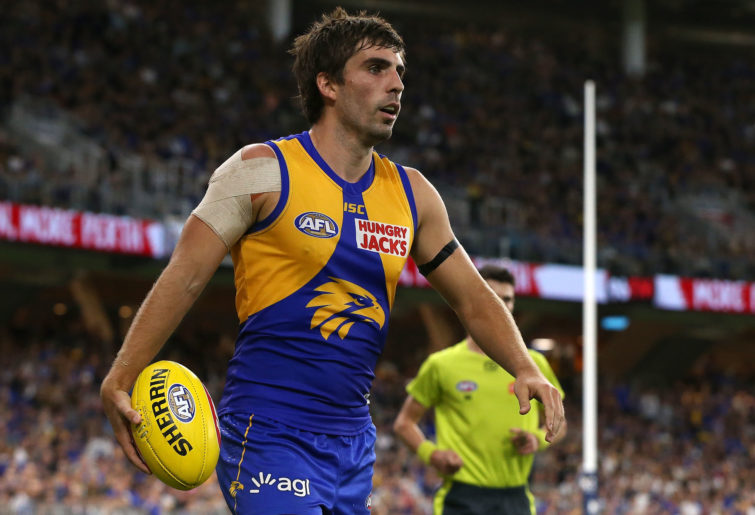
(Photo by Paul Kane/Getty Images)
The best clubs understand that the draft isn’t the panacea to all their list deficiencies and typically make better use of the draft than clubs that struggle to ‘sustain’ success.
St Kilda is one club in particular that appears to have changed its list management strategy to approximate the method followed by the perennial contenders – Hawthorn, Geelong, Sydney and West Coast – recognising that the draft is but one way to bolster your list and given picks are a speculative tool, if you can trade them for established talent in the 22-26 years age range, it will often be better to do so.
St Kilda snagged Daniel Hannebery last year – a risky move given his injury history and age but a necessary gamble for a ‘smaller’ club looking to break free from the bottom reaches of the ladder – and landed all of Dougal Howard, Paddy Ryder, Brad Hill and Zak Jones this year.
Most draft picks, outside the select few stars that acclimate to the AFL seamlessly, take several years to start making a genuine impact, if at all, and clubs like Hawthorn are expert at identifying undervalued or unhappy players that have already been developed by their original clubs.
Notwithstanding that Hawthorn’s cherrypicking has been aided by the inevitable list squeeze that occurred at the Giants, Swans, and Suns once their salary caps contracted to normal levels, this approach is likely to bear more fruit than too heavily focusing on the draft.
It’s hardly necessary to keep track of the picks traded for the likes of Tom Scully, Tom Mitchell and Jaeger O’Meara because the likelihood is strongly in favour of Hawthorn coming out on top.
With this in mind, it would be sensible for the less-supported clubs to focus their attention on identifying above-average to good players and players that have been pigeonholed and played out of position rather than putting all their eggs in the superstar basket. As we have seen repeatedly with North Melbourne, the absolute top tier of players are not likely to go to the ‘minnows’.
This doesn’t mean that those sides shouldn’t have a crack, but when the best-laid plans fail, the backup should be a fair sight better than the likes of Paul Ahern, Marley Williams and Aaron Hall (it’s not all bad news for North. Shaun Higgins has been a great success story and Jared Polec and Jasper Pittard are solid, but just not my cup of tea at the prices they reportedly fetched).
It’s a harsh reality, but if you have your pick of the litter, why wouldn’t you go to a well-resourced club with a large fan-base?
Clubs like St Kilda and the Western Bulldogs, who landed good key position players in Josh Bruce and Alex Keath, have adapted to this reality and it bodes well for their future contention. Both sides appear well placed to take significant steps forward this year, and not based on the Marsh Community Series which is so often a false dawn, but on smart list management.
All of this is really to say that there are not enough good players available each year for 18 pigs at the trough. Someone is always going to miss out, but the so-called small clubs will fare a lot better by setting realistic targets.
The Saints and the Dogs have made hay doing so recently.
And as for Naitanui, Swallow and Watts, the first two seem best placed to play the footy it was anticipated they would when drafted, at least provided Nic Nat stays fit. Given Watts’ terrible injury it will be a bonus if he can just stay fit and string games together regardless of whether it’s at SANFL or AFL level.
I’ll be wishing the best for each of them.































































































